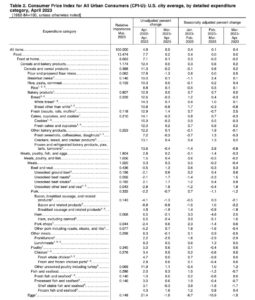Beef prices are projected to continue increasing as U.S. beef production declines with no signs of a cattle herd rebuild. Additionally, cheap beef may soon become further out of reach…
Food Prices Climb 7.7 Percent Over the Last Year
Gabriel T. Rubin reported on the front page of today’s Wall Street Journal that, “Inflation edged slightly lower in April, likely keeping the Federal Reserve on course to pause interest-rate increases at its next meeting.
“The consumer-price index rose 4.9% in April from a year earlier, the Labor Department said Wednesday, down from March’s 5% increase. The inflation reading has declined from a recent peak of 9.1% in June 2022, but remains historically high.”

“Wednesday’s report makes it easier for the Fed to pause rate increases because it showed price pressures aren’t worsening and might soon be slowing. The Fed has aggressively raised rates for more than a year to try to tame inflation by slowing economic activity. The central bank is looking to see signs of inflation declining toward its 2% target,” the Journal article said.
Rubin pointed out that,
Food prices have remained flat over the past two months, though a decline in grocery prices in April was offset by a rise in prices for dining out.
And New York Times writer Madeleine Ngo reported yesterday that, “Food prices were flat for a second straight month in April, relief for many Americans who have faced higher costs at the grocery store in recent months.
“That is a big improvement from February, when prices rose 0.4 percent over the month.
“Prices for food at home fell 0.2 percent in April compared with the month before. Prices for food at restaurants continued to pick up, rising 0.4 percent over the month, a slight decline from 0.6 percent in March.”
The (CPI) #food index was unchanged in April.
— FarmPolicy (@FarmPolicy) May 10, 2023
The food at home index fell 0.2 percent over the month, following a 0.3-percent decrease in March.
Four of the six major grocery store food group indexes decreased over the month. pic.twitter.com/lyr3sZBHU6
“Despite the relief in food price growth, costs are still much higher than they were before the pandemic. Overall, food prices have climbed 7.7 percent over the last year,” the article said.
#Food at home, CPI 12-month percentage change. pic.twitter.com/mlWihkGoTm
— FarmPolicy (@FarmPolicy) May 10, 2023
Ngo explained that, “Prices for fruits and vegetables decreased 0.5 percent over the month, and the index for meats, poultry, fish, and eggs also declined 0.3 percent. Prices for milk fell 2 percent, the largest decline since February 2015. Egg prices, which spiked after an outbreak of avian influenza and the cost of fuel, feed and packaging rose, fell 1.5 percent after a 10.9 percent decline in March.”

The Times article noted that, “Food prices started shooting up about two years ago as the cost of labor, transportation and raw materials picked up. Other factors, such as the higher cost of marketing and packaging food products, have also resulted in companies passing along those increases to consumers. Weather-related events, such as extreme droughts in the Western United States, have diminished crop yields and pushed up supply costs.
“Economists said food prices could be starting to moderate as labor pressures eased and wage growth across the industry slowed in recent months. Recent declines in fuel prices have also helped bring down transportation costs.
“The prices that consumers pay for food at restaurants are typically slower to change because more labor costs are involved.”





